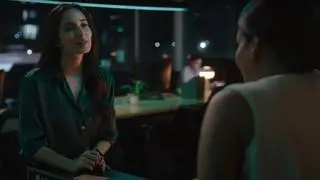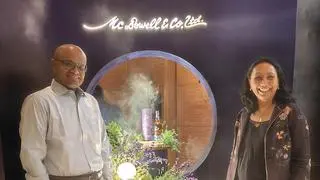There are well over 1,50,000 commercial fonts in the world today. “Why do we need more fonts?, an eager young student from the Unitedworld Institute of Design asks Peter Bil’ak, the well-known Slovakian designer who runs Typotheque, a type foundry, out of the Netherlands.
Bil’ak has a ready answer for the student. “There are over 7,000 languages today, but a disproportionately large number of existing fonts are only Latin-based,” he says. Communication is global today, so we need fonts that speak in all languages, he explains. Also, fonts that are optimised to work on digital media as well as they do in print are needed, he points out. Repurposing fonts for use on web is a major work today.
Above all, several brands require exclusive fonts to build an identity for themselves.
The soft-spoken creative whiz, who also runs an art and design journal called Dot Dot Dot , was in Ahmedabad for the India Design Confluence, a festival that has brought under one roof all types of designers — from automobile to product to typeface to fashion. Bil’ak’s session on typeface design is eye-opening.
“Typefaces are like voices. Just like some voices are bland and easy to ignore, while other voices are engaging, typefaces can be the same,” he says. Fonts emotionally impact you and using the right fonts in communication is very important, he says. It’s a riveting presentation taking you through the history of fonts, the imperatives of typeface design (we stand to lose hundreds of languages that are not coded, he says), the work his foundry is doing, and what constitutes good design.
Later, on catching up with Bil’ak, who has developed fonts for Kannada paper Prajavani , he shares insights on why typefaces are important for brand building.
Fonts shape identity
Typography is the heart of all communication today, he stresses. “If you transcribe what I speak, you will miss out all the nuances. But typefaces allow you to convey the emotion. That’s why brands rely so much on fonts to deliver the impact they seek,” he says.
Typotheque does custom bespoke fonts for several brands. For instance, for Mozilla, it has developed an exclusive font for both its logo as well as the search engine. It is an ongoing project. It has also done custom fonts for World Press Photo in the Netherlands.
“For them the new font was necessary to define their identity,” says Bil’ak, describing how WPP is a fairly generic sort of name and copied in many countries. They were using the Futura font and wanted a new font developed to protect their identity.
Typefaces are the identity of newspapers as well. “For newspapers, change of font can be a very sensitive decision as readers don’t take kindly to it,” says Bil’ak. “It is like breaking into a house and changing things around. It can get challenging for the resident or user.” Certain conventions need to be kept in typeface design. If you break these rules, people feel alienated, points out Bil’ak, describing how they test each font they develop online.
Time and costs
How long does it take to create fonts? For newspapers it can take over a year, says Bil’ak as the level of complexity is high. But for brands which require just one or two fonts, it can be done in a month.
Why do brands need to do bespoke fonts? Can’t they just use one from an existing pool? The difference, says Bil’ak, is like that between readymade fashion and tailor-made. The latter is time-consuming but defines your personality better. “We go through the ethos of the brand, the archives and what communication they use and need, and develop fonts accordingly,” he says.
How about costs? For brands that want fonts with limited time exclusivity, say, three years, it could be about $10,000. But Bil’ak says they have also done work that has cost ten times that amount which comes with perpetual exclusivity.
The price consists of three different factors — how many languages does the font have to support; second, how many different expressions of the font (itals, bold, and so on) you need; and the third factor is exclusivity. “Sometimes, we develop a font for a brand, but we just charge them a ‘licence to use’ fee and can sell it to other people too. That works out cheaper,” he says.
In the old days, visual identities would last far longer — for instance, something developed in the ‘60s would last 35 years. Today, the average age of redesign is four-and-a-half years. That said, Bil’ak stresses the need for brands to keep continuity in their designs so that their legacy is not lost.
Talking inclusive
One of the largest projects Typotheque is doing is for the Paris Underground, where Bil’ak and his team are working on signages. “We are working on five different languages. We looked at how people find their way when they are underground and everything looks so uniform and same.”
Traditionally, says Bil’ak, the signage at most underground systems is uniform — that’s why people miss stations and lose their bearings. So they are making each station have a unique signage. “Even audio announcements are different — so you won’t need to understand but can feel you are in the right spot,” he says. This, he says, will positively impact the perception of tourists visiting Paris.
Favourite fonts
Finally, which is Bil’ak’s favourite typeface? Among the ones he has developed, he names Federa (the first one designed by his company and most successful) and Greta Sans, a more subtle and mature design.
“From fonts that I didn’t design, there is a beautiful font called Lexicon made by a Dutch designer. It was used by a newspaper and it was so beautiful that sometimes it could not convey a tragic happening. It made me realise that fonts should not always be a thing of beauty but need to be able to reflect ugliness also.”








Comments
Comments have to be in English, and in full sentences. They cannot be abusive or personal. Please abide by our community guidelines for posting your comments.
We have migrated to a new commenting platform. If you are already a registered user of TheHindu Businessline and logged in, you may continue to engage with our articles. If you do not have an account please register and login to post comments. Users can access their older comments by logging into their accounts on Vuukle.